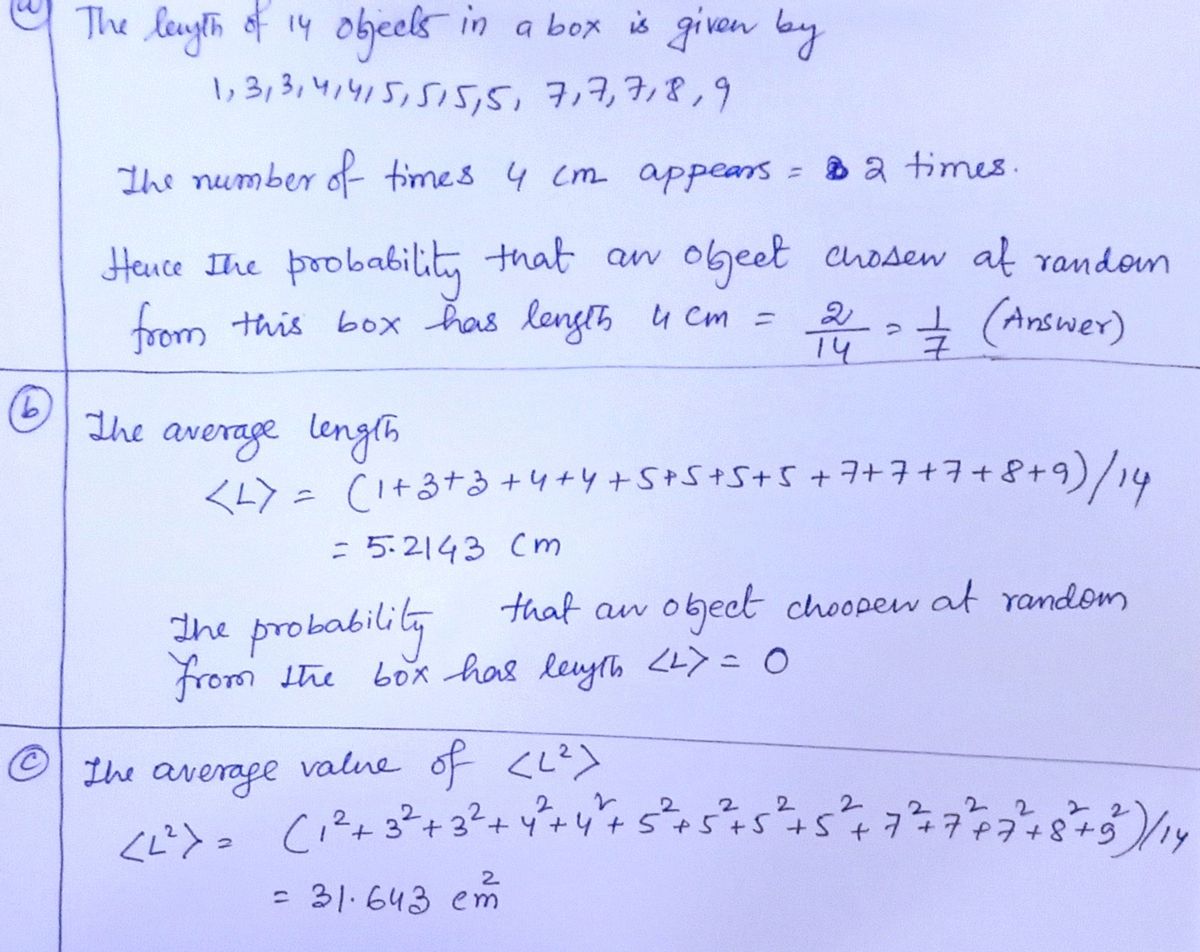3. [5] Practice with Statistics. Feel free to use a calculator (or spreadsheet) to add/divide/etc, but please don't use built-in statistical functions. You measure the lengths of 14 objects in a box, and get the following results (in cm): 1; 3; 3; 4; 4; 5; 5; 5; 5; 7; 7; 7; 8; 9 a) What is the probability that an object chosen at random from this box has length 4 cm? (Here and below, assume equal probability for selecting any one object) b) What's the average length (L) (also called the expectation value of length) of the objects? What is the probability that an object chosen at random from the box has length = (L) ? c) What is the average value of the square of the lengths, (L²) ? d) Use your results to find the standard deviation of lengths of objects in this box e) What is the probability that the length of an object chosen randomly from this box is in the range (L) ±o? (Given what you know about stand. deviation, does this seem reasonable?)
3. [5] Practice with Statistics. Feel free to use a calculator (or spreadsheet) to add/divide/etc, but please don't use built-in statistical functions. You measure the lengths of 14 objects in a box, and get the following results (in cm): 1; 3; 3; 4; 4; 5; 5; 5; 5; 7; 7; 7; 8; 9 a) What is the probability that an object chosen at random from this box has length 4 cm? (Here and below, assume equal probability for selecting any one object) b) What's the average length (L) (also called the expectation value of length) of the objects? What is the probability that an object chosen at random from the box has length = (L) ? c) What is the average value of the square of the lengths, (L²) ? d) Use your results to find the standard deviation of lengths of objects in this box e) What is the probability that the length of an object chosen randomly from this box is in the range (L) ±o? (Given what you know about stand. deviation, does this seem reasonable?)
Related questions
Question
I need some help with this
![3. [5] Practice with Statistics. Feel free to use a calculator (or spreadsheet) to add/divide/etc,
but please don't use built-in statistical functions.
You measure the lengths of 14 objects in a box, and get the following results (in cm):
1; 3; 3; 4; 4; 5; 5; 5; 5; 7; 7; 7; 8; 9
a) What is the probability that an object chosen at random from this box has length 4 cm? (Here
and below, assume equal probability for selecting any one object)
b) What's the average length (L) (also called the expectation value of length) of the objects?
What is the probability that an object chosen I random from the box has length = (L) ?
c) What is the average value of the square of the lengths, (L²) ?
d) Use your results to find the standard deviation o of lengths of objects in this box
e) What is the probability that the length of an object chosen randomly from this box is in the
range (L) ±o? (Given what you know about stand. deviation, does this seem reasonable?)](/v2/_next/image?url=https%3A%2F%2Fcontent.bartleby.com%2Fqna-images%2Fquestion%2F9b00a09c-5597-457d-8151-edd0c392eea7%2F165b7728-175b-4d0c-829c-a917bdca776b%2Foqxizi_processed.png&w=3840&q=75)
Transcribed Image Text:3. [5] Practice with Statistics. Feel free to use a calculator (or spreadsheet) to add/divide/etc,
but please don't use built-in statistical functions.
You measure the lengths of 14 objects in a box, and get the following results (in cm):
1; 3; 3; 4; 4; 5; 5; 5; 5; 7; 7; 7; 8; 9
a) What is the probability that an object chosen at random from this box has length 4 cm? (Here
and below, assume equal probability for selecting any one object)
b) What's the average length (L) (also called the expectation value of length) of the objects?
What is the probability that an object chosen I random from the box has length = (L) ?
c) What is the average value of the square of the lengths, (L²) ?
d) Use your results to find the standard deviation o of lengths of objects in this box
e) What is the probability that the length of an object chosen randomly from this box is in the
range (L) ±o? (Given what you know about stand. deviation, does this seem reasonable?)
Expert Solution
Step 1: Step 1

Step by step
Solved in 3 steps with 2 images
